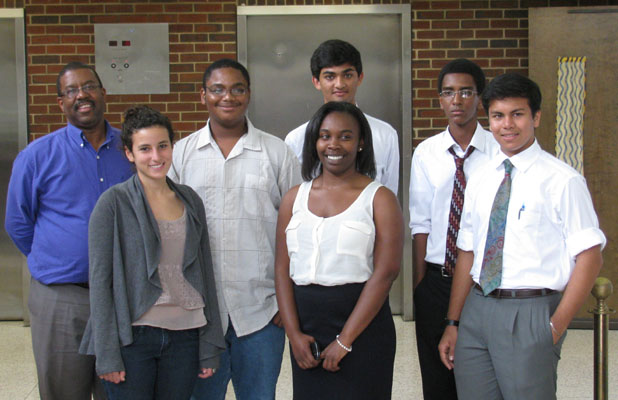|
HB 1264(6) recognized
the Historic significance of Historical Minority Institutions
(HMI), ordered the University to formulate signature programs at
them and not to diminish their role. The study stated "
“Signature programs” have been defined as those that are
distinctive, that build on existing strengths, that advance
the institution’s profile, and that serve regional and/or state
economic transformation needs." Study identified as an emerging
area Advanced Materials -- Nanotechnology. |
 NC
A&T is "well known in areas such as advanced materials,
nanotechnology,
computational science, and says
N. Radhakrishnan, former for research and economic
development at N.C. A&T. The school also has significant
strengths in other areas, including biotechnology,
energy and the environment, information sciences and
technology, logistics and transportation
development. NC
A&T is "well known in areas such as advanced materials,
nanotechnology,
computational science, and says
N. Radhakrishnan, former for research and economic
development at N.C. A&T. The school also has significant
strengths in other areas, including biotechnology,
energy and the environment, information sciences and
technology, logistics and transportation
development. |
 |
|
All these endeavors are
aligned in eight research clusters that bring faculty
together across disciplines to
develop large research
projects.
These
research clusters run in parallel with a number of
multidisciplinary centers and institutes at N.C. A&T,
which develop partnerships with private and corporate
sponsors, educational institutions, and government
agencies. This includes two US Army Centers of
Excellence that are working on projects to enhance the
capabilities of soldiers on the battlefield. [3]
|
|
|
|
"Almost
all of the occupations which will be affected by nanotechnology
will require a BS in engineering with a broad, interdisciplinary
and multi-disciplinary approach, and an understanding not only
of electrical, mechanical
and civil engineering,
but biology, physics and chemistry as well ". |
|
In 2006 in the category of Doctorial
Granting Universities NC A&T was rated as a High
Research University in the Carnegie Foundation
classification of colleges and universities.
NC A&T
the largest producers of BS. and PhD minority engineers
in the country, offers approved master's degrees in
Civil |
 |
|
|
University Centers/Institutes Focusing on
Nanotechnology, A Roadmap for Nanotechnology in North
Carolina’s 21st Century Economy, APRIL 2006, NC Board of
Science & Technology |
|
|
Engineering, Chemistry, Biology,
Industrial Systems & Systems Engineering, Electrical
Engineering, Mechanical Engineering, Computer Science,
Chemical Engineering, Physics, Computational Science and
Engineering, as well as doctoral degrees in Energy and
Environmental Systems
|
|
 |
|
PCG/UNC-NCCCS/UNC
Interim report 3.doc/RB.SP.PC.CR.ATPCC.1/CC.14/10May05 (34)
|
 |
|
Southern Association
of Colleges and Schools (NC A&T) |
|
Engineering, computational Science and Engineering, Electrical
Engineering, Mechanical Engineering, and Industrial and Systems
Engineering. |
|
Nano
scale Technologies are Experimental |
|
In 2011 HMI North Carolina A&T
for the 7th consecutive year garnered the third
largest highest amount of sponsored research in 17
constituent UNC system surpassed only by UNC flag ships
UNC-Chapel Hill and NC A&T holds patents in Advanced
Materials,
Nanotechnology, |
Biotechnology, Computational Science, Environmental
Sciences, Transportation Systems, and Public Health,
for seventh consecutive year achieved the third
highest research funding in the 16-constituent
University of North Carolina System with over $60
million dollars.
|
North
Carolina A&T Nano Centers |
-
Center for Advanced Materials and Smart
Structures
-
Center for Nanoscale
Chemical-Electrical-Mechanical Manufacturing
Systems
-
Engineering
Research Center for Revolutionalizing
Metallic Biomaterials
-
Center for Nanoscience and Nanomaterials
|
|
UNC at
Greensboro Nanoscience Centers |
-
Center of Research Excellence in
Nanobiosciences
Source: North Carolina Board of Science and
Technology |
|
 |
|
NC A&T
Sponsored Research 2001 - 2011 |
|
|
NCA&T State University has been funded at an
average rate of $3-5 million per year in the
area of nanoscience and nanotechnology. Most of
the research in nanoengineering is done in the
Center for Advanced Materials and Smart
Structures (CAMSS). Several Centers and projects
are under CAMSS, including the NSF Center for
Research Excellence in Science and Technology
(CREST), the DoD Center for Nanoscience,
Nanomaterials and Multifunctional Materials
(CNN) for Homeland Security, the NSF Nanoscale
Science and Engineering Center (NSEC), the NSF
project on US/Europe Materials Collaboration:
Self-Organized Nanostructured Thin Films for
Catalysis, the NSF project on Nanoscale
Interdisciplinary Research Teams (NIRT), the NSF
Major Research Instrumentation for
Nanoengineering Research, and the NSF
Nanotechnology Undergraduate Education (NUE)
program. CAMSS also facilitates many of the
materials research activities of the
NASA-National Institute for Aerospace (NIA). In
addition, the Center for Composite Materials
Research (CCMR) does research in nano-enhanced
composite materials and the Army Center of
Excellence for Battlefield Capability
Enhancements (Flexible Displays) does research
in material characterization and development of
novel displays. [ ] |
|
 |
|
| |
|
 FIRST
LADY MICHELLE OBAMA TO KEYNOTE N.C. A&T COMMENCEMENT
FIRST
LADY MICHELLE OBAMA TO KEYNOTE N.C. A&T COMMENCEMENT














 A&T
MECHANICAL ENGINEERING STUDENT WINS FIRST
TEST-BED COMPETITION FOR INNOVATION AND
TRANSLATION AT NSF ERC ANNUAL CONFERENCE
A&T
MECHANICAL ENGINEERING STUDENT WINS FIRST
TEST-BED COMPETITION FOR INNOVATION AND
TRANSLATION AT NSF ERC ANNUAL CONFERENCE 